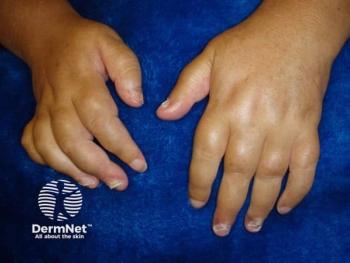
- Dermatology Times, October 2022 (Vol. 43. No. 10)
- Volume 43
- Issue 10
Exploring the Relationship Between Psoriatic Arthritis and Psoriasis
Two expert dermatologists discuss the relationship between PsA and PsO in this DermView series recap.
Patients with arthritis are often first diagnosed with psoriasis. In this excerpt from a Dermatology Times® DermView video episode1, 2 physicians explored the relationship between the skin and joint disorders, why the two are often related, and some of the medications that may bring relief for patients with both conditions.
Relationship Between Psoriatic Arthritis and Psoriasis
“About a third of our [patients with psoriasis] go on to psoriatic arthritis [PsA]...and we know there are certain risk factors that increase the likelihood that a patient is going to develop psoriatic arthritis. That includes factors such as nail disease, inverse psoriasis, scalp psoriasis, more severe psoriasis, obesity, and family history of psoriatic arthritis, specifically in a first- or second-degree [relative],” said Joseph Merola MD, MMSc, vice chair of clinical trials and innovation in the Department of Dermatology, director of the Clinical Unit for Research Innovation and Trials, and director of the Center for Skin and Related Musculoskeletal Diseases at Brigham and Women’s Hospital and associate professor of dermatology and rheumatology at Harvard Medical. Although there may be a genetic risk factor, with overlap-ping risks between skin and joint disease, environmental factors can also trigger the immune response that becomes psoriasis and leads to psoriatic arthritis.
Mark Lebwohl, MD, dean of clinical therapeutics at the Kimberly and Eric J. Waldman Department of Dermatology at Icahn School of Medicine at Mount Sanai in New York, New York, noted that 70% of patients with arthritis are first diagnosed with psoriasis and that arthritis occurs before psoriasis 15% of the time. Plaque psoriasis is the predominant presenting form of psoriasis.
Lebwohl then explained the domains of the disease and the different preexisting conditions that dermatologists see in many patients before a diagnosis, including nail disease, scalp disease, or inverse and intertriginous psoriasis. “I would say close to 20% come in with guttate psoriasis. [Pustular psoriasis and erythrodermic psoriasis are exceedingly rare], but those are deadly ones.... And of course, in plaque [psoriasis] we include inverse palm and sole psoriasis, [which is] less common than just plaque psoriasis.”
Some patients also show signs of other types of arthritis, including the following:
- Axial PsA, which involves sacroiliitis, the inflammation of 1 or more joints where the lower spine connects with the pelvis
- Dactylitis, which involves the global swell-ing of a finger or toe
- Enthesis, which is inflammation at sites where the tendon or ligament connect to the bone
Treatment Options
The treatments for PsA also work for psoriasis. The physicians discussed a few widely used treatments such as TNF-α blockers, IL-17 blockers, and Janus kinase inhibitors. Several Janus kinase inhibitors were approved in 2022 for the treatment of psoriasis and PsA, and Lebwohl said they work well, despite some boxed warnings that come with the drugs. He added that doctor involvement is key. It is up to the physician to ask questions to help the patient pinpoint the source of pain or stiffness. The physicians discussed the reasons a physician may choose one category of drug over another. They agree that TNF-α blockers have the best evidence to date that they prevent heart attacks. For patients who have preexisting heart conditions, a drug in that category would be the first line of defense. Lebwohl explained this is important because of a marked increase in the risk of heart attacks in patients with psoriasis. If a patient has or had skin cancer, a TNF-α blocker would not likely be the first choice, because a side effect is an increased risk of squamous cells.
In addition, they mentioned that patients with PsA who are pregnant could benefit from certolizumab pegol (Cimzia), a drug that does not contaminate breast milk and therefore will not cross the placenta. Dermatologists often start women of childbearing years on certolizumab pegol for that reason.
The patient’s weight also factors into some treatment plans. “We know that one of the unique aspects of some of our infusion therapies, in particular infliximab (Remicade; Janssen Biotech, Inc), is that it is weight-based dosing,” Merola said. “It does offer—albeit off-label—dose flexibility around frequency dosing, IV [intravenous] dosing that is...weight based but has flexibility around frequency. I can do it every 4 weeks, every 8 weeks. I can do 5 mg/kg. I can do 10 mg/kg.”
Merola noted that some of the highest efficacy in PsA was shown in findings from the GO-VIBRANT trial (NCT02181673) that examined intravenous golimumab (Simponi Aria).
The physicians also mentioned treatment options when a drug fails to yield positive results. Lebowhl and Merola described primary failure as the ineffectiveness of a drug; no history of a response. A secondary failure, they said, indicates a lack of response after an initial period of success. A practitioner may prescribe a new classification of drugs for a patient who experiences primary failure. In a secondary failure, the doctor may have to increase the dosing or move to a new treatment plan. Merola said that one cause for secondary failure is due to the patients’ development of antibodies; they would then have to prescribe an additional medication to suppress their formation.
Both physicians agreed that the number of drugs available for PsA is always increasing, which means more access for doctors and patients. “We have robust data from studies that support that switching [medications] seems to be well tolerated, seems to continue efficacy for our patients with these disorders,” Merola said. However, patients often have negative expectations about what changing drugs means, which may lead to confusion, more calls to the office, or failure to take the drugs.
Merola and Lebwohl concluded by talking about the importance of regular screenings for PsA or psoriasis patients. Merola suggested a frequency of every 6 months to record new or worsening symptoms and to keep track of disease progression.
Transcript edited for clarity and conciseness.
Reference
- Lebwohl M, Merola J. PsO, PsA and Candidiasis. DermView. August 18, 2022. Accessed August 29, 2022. https://www.dermatologytimes.com/view/overcoming-diagnostic-delay-in-psoriasis
Articles in this issue
about 3 years ago
A Close Look at Necrobiosis Lipoidicaabout 3 years ago
The Dx and Rx of Congenital Malalignment Syndrome in Childrenabout 3 years ago
Pediatric Nail Disordersabout 3 years ago
Innovation Leads to “Windfall” in Dermatologyabout 3 years ago
The Psychosocial Impact of Skin Diseases in Childrenabout 3 years ago
New Directions in the Treatment of Basal Cell Carcinomaabout 3 years ago
Overview of Prurigo Nodularis for Practicing Dermatology Cliniciansabout 3 years ago
Impacts of the Inflation Reduction Act on Doctorsabout 3 years ago
A Look at the Rise in Adult Acne in WomenNewsletter
Like what you’re reading? Subscribe to Dermatology Times for weekly updates on therapies, innovations, and real-world practice tips.


















